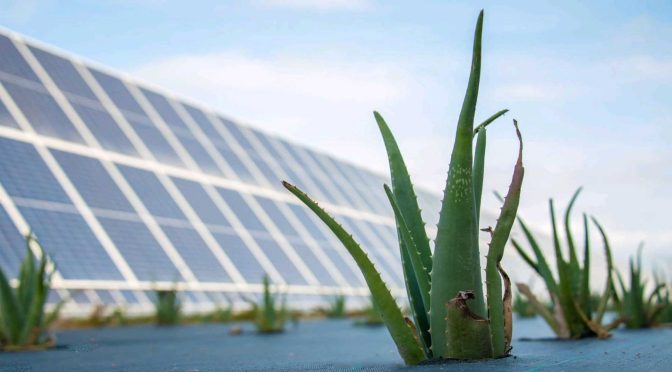The first results of Enel Green Power’s experimental European program in favour of a new agrivoltaic model, capable of combining the production of clean and affordable electricity through ground-mounted photovoltaic systems and agricultural production, are very encouraging, both in terms of agricultural yield and of greater wellbeing of animals and pollinating species.
Today, it’s possible to find sustainable solutions that combine agricultural production and the generation of low-cost green energy, as the first data from our Europe-wide agrivoltaic trial shows.
At the end of January, we launched a large Europe-wide demonstration program involving sites in three countries: five in Spain, two in Greece and two in Italy. This is a real feasibility test on several levels. First of all, the territorial one, through the virtuous coexistence of crops, wildlife and ground mounted photovoltaic panels. Second, the technological one, through the testing of various panel technologies and system configurations (single- and double-sided panels, fixed and tracking structures). And finally the social one, through collaboration between stakeholders from the world of research, innovation, agriculture and industry, and their specific skills.
A good example of this is our “sustainable solar park” program, which is based on the multiple use of land through the coexistence of renewable energy production from solar sources with ground panels and agricultural activity (whether it is only cultivation or also includes grazing animals). It also promotes a collaborative approach with different stakeholders, farmers and local communities, to create new business models, tailored to the specific site. This is what we call solar-inclusivity. This program not only promotes the integration and coexistence of multiple businesses, it also fosters the adoption of advanced and innovative agricultural techniques with high-tech and digital tools to the advantage not only of agricultural partners, who can improve their competitiveness on the market, but also of electricity production, which can benefit from a higher level of monitoring of technical and environmental parameters.
Virtuous effects
The results that have emerged from these first months of experimentation are not only very encouraging but have shown how the collaboration between agriculture and the photovoltaic world fosters virtuous effects capable of generating mutual benefit for crops and the production of solar energy. In fact, by virtue of the lower temperatures induced by the presence of crops, an increase in the efficiency of the solar panels was observed to the benefit of electricity production; and thanks to the partially shaded and intermittent conditions due to the presence of photovoltaic panels, the growth of some plants and their fruits has clearly improved, since the thermal stress due to high solar radiation and high temperature has been minimized. These are two consequences of climate change to which crops will be increasingly subjected in the future. And, looking to the future, it’s impossible not to think about water consumption: even in this case, agrivoltaics has shown itself to be a winning strategy. The photovoltaic system has created microclimate conditions favourable to a reduction of up to 15-20% of water used for crops.
In the crops placed between the rows of panels, the tests conducted showed an increase of up to 60% in the agricultural yield and average weight of the fruits of some horticultural species such as peppers, and an increase of up to 30% in the number of fruits compared to control areas without photovoltaic systems. And that’s not all: plants like aloe vera showed an increase in biomass of between 50-60%, and for other species of aromatic, medicinal, leguminous and forage plants, a higher yield of between 30% and 60% was noted.
“The confirmations we’re obtaining from the ongoing experiments with our agricultural and scientific partners clearly demonstrate that there is no competition between ground photovoltaic systems and agricultural production; on the contrary, photovoltaic production and agriculture can complement each other synergistically and coexist with positive effects for both activities. In this way, it’s possible to combine the need to provide clean low-cost electricity to people and businesses with more effective land use, preserving biodiversity and generating economic growth. The agrivoltaic sector is a new sustainable model that we intend to adopt in all those cases where it can help generate shared value with the communities in which we operate”.
Nicola Rossi, Head of Innovation EGP
Protecting biodiversity
Another fundamental aspect of EGP’s agrivoltaic approach is the safeguarding and restoration of biodiversity, and the protection of pollinating species. For this reason, alongside the concept of solar-inclusivity, we’ve created the concept of solar-diversity: we consider all the areas made available by the photovoltaic corridors and even the marginal areas close to the plant to create oases of biodiversity.
This “biodiversity everywhere” approach aims to avoid habitat fragmentation by promoting ad hoc wildlife settlement areas and allows the introduction of pollinator colonies to improve ecosystem services, including for the benefit of the surrounding agricultural areas.
In the test sites, species were also selected on the basis of their risk of extinction due to climate change, and suitable settlement habitats were created for them. This is the case of some wild pollinators such as butterflies, which are model animals given their high sensitivity to the alteration or improvement of environmental conditions. Or birds of the steppe, which nest on the ground and are therefore exposed to considerable risks in the presence of agricultural machinery. In this case, ecological corridors have been created between the rows of panels by sowing particular species of legumes that allow the nesting and sustenance of these birds, as well as oxygenating the soil and improving its characteristics.


